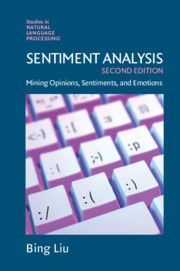Book contents
- Sentiment Analysis
- Studies in Natural Language Processing
- Sentiment Analysis
- Copyright page
- Contents
- Preface
- Acknowledgments
- 1 Introduction
- 2 The Problem of Sentiment Analysis
- 3 Document Sentiment Classification
- 4 Sentence Subjectivity and Sentiment Classification
- 5 Aspect Sentiment Classification
- 6 Aspect and Entity Extraction
- 7 Sentiment Lexicon Generation
- 8 Analysis of Comparative Opinions
- 9 Opinion Summarization and Search
- 10 Analysis of Debates and Comments
- 11 Mining Intent
- 12 Detecting Fake or Deceptive Opinions
- 13 Quality of Reviews
- 14 Conclusion
- Appendix
- Bibliography
- Index
3 - Document Sentiment Classification
Published online by Cambridge University Press: 23 September 2020
- Sentiment Analysis
- Studies in Natural Language Processing
- Sentiment Analysis
- Copyright page
- Contents
- Preface
- Acknowledgments
- 1 Introduction
- 2 The Problem of Sentiment Analysis
- 3 Document Sentiment Classification
- 4 Sentence Subjectivity and Sentiment Classification
- 5 Aspect Sentiment Classification
- 6 Aspect and Entity Extraction
- 7 Sentiment Lexicon Generation
- 8 Analysis of Comparative Opinions
- 9 Opinion Summarization and Search
- 10 Analysis of Debates and Comments
- 11 Mining Intent
- 12 Detecting Fake or Deceptive Opinions
- 13 Quality of Reviews
- 14 Conclusion
- Appendix
- Bibliography
- Index
Summary
Starting from this chapter, we discuss the main research topics of sentiment analysis and their state-of-the-art algorithms. Document sentiment classification (or document-level sentiment analysis) is perhaps the most extensively studied topic in the field of sentiment analysis so far, especially in its early days (see the surveys by Pang and Lee, 2008a; Liu, 2012). It aims to classify an opinion document (e.g., a product review) as expressing a positive or a negative opinion (or sentiment), which are called sentiment orientations or polarities. This task is referred to as document-level analysis because it considers each document as a whole and does not study entities or aspects inside the document or determine sentiments expressed about them. Arguably, this task is the one that popularized sentiment analysis research. Its limitations also motivated the fine-grained task of aspect-based sentiment analysis (Hu and Liu, 2004) (Chapters 5 and 6), which is widely used in practice today.
- Type
- Chapter
- Information
- Sentiment AnalysisMining Opinions, Sentiments, and Emotions, pp. 55 - 88Publisher: Cambridge University PressPrint publication year: 2020



